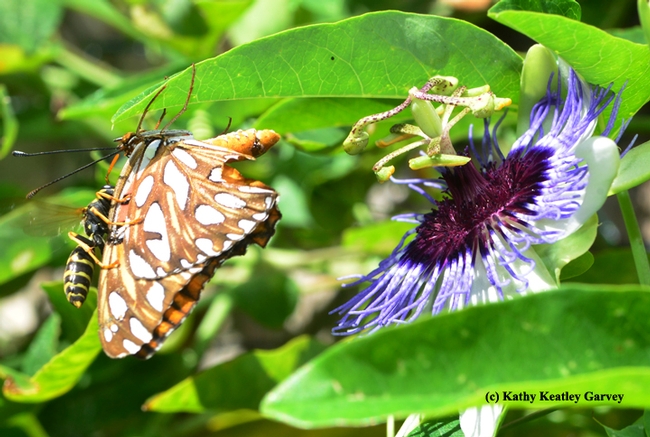When you're trying to rear Gulf Fritillary butterflies (Agraulis vanillae), expect the expected: predators.
It doesn't take long for European paper wasps (Polistes dominula) to find the butterfly's host plant, the passionflower vine (Passsiflora) and prey. We've seen the wasps, with their long hind legs dangling, follow the butterflies as they flit from tendrils to leaves to lay their eggs. The wasps grab the tiny yellow eggs and squirming caterpillars and rip into chrysalids.
They'll attack adult butterflies, too, especially the crippled ones.
Then off they fly with bits of food--protein--for their colony. Wasps are carnivores (unlike their cousins, the honey bees, which are vegetarians).
The European paper wasp, so named because of its European origin, is relatively new to the United States. Scientists tell us that the P. dominula was not recorded in North America until 1981. P. dominula was first discovered in the United States in the late 1970s near Boston, Mass. This invasive species has since spread rapidly across the country. Entomologists worry that it is displacing the native species of Polistes wasps.
Have you ever seen these wasps attack other insects? Butterflies?
Last Sunday we were watching a crippled butterfly (no doubt crippled by a predator such as a bird or praying mantis) clinging to a Passiflora leaf as males tried unsuccessfully to mate with her. Eventually, the males all fluttered away and a European paper wasp patrolling the area zeroed in for the attack.
Like a hungry lion singling out a crippled gazelle from a stampeding herd, the European paper wasp knew just what to do.
Attached Images:

European paper wasp targets a crippled Gulf Fritillary. (Photo by Kathy Keatley Garvey)

A European paper wasp attacks a crippled Gulf Fritillary. (Photo by Kathy Keatley Garvey)

The injured abdomen of the Gulf Fritillary. (Photo by Kathy Keatle Garvey)

European paper wasp grips the Gulf Fritillary. (Photo by Kathy Keatley Garvey)